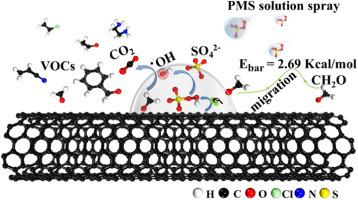Journal of Hazardous Materials ( IF 12.2 ) Pub Date : 2020-11-26 , DOI: 10.1016/j.jhazmat.2020.124684 Zhenhua Dai , Didi Li , Zhimin Ao , Shaobin Wang , Taicheng An

|
Carbon-catalyzed persulfate activation for the removal of gaseous volatile organic compounds (VOCs) has not been reported yet, and the corresponding fundamental mechanisms of VOCs adsorption and the subsequent VOCs degradation remain controversial. In this work, theoretical chemistry calculations were carried out to explore the VOCs removal mechanism by the persulfate-based advanced oxidation processes (P-AOPs) for VOCs removal over single walled carbon nanotubes (SWCNT). This study provided detailed theoretical insights into the SWCNT/P-AOPs for VOCs treatment in terms of adsorption, activation, mineralization, and diffusion of VOCs or peroxymonosulfate (PMS). Various VOCs were found to be preferentially adsorbed onto SWCNT, and the adsorption strength of VOCs was found to be significantly dependent on their polarizability. On the other side, PMS adsorbed on SWCNT could be efficiently activated through accepting electron in the sp2 carbon matrix of SWCNT rather than the electrons at dangling bonds to generate •OH radicals attributed to the strong interaction between PMS and SWCNT. Formaldehyde was then taken as an example to evaluate the catalytic degradation pathways via SWCNT/P-AOPs. Under the attack of •OH radicals, the ultrafast degradation pathway of formaldehyde with no byproduct CO was identified with ultralow reaction energy barrier and large energy release. In addition, factors affecting the adsorption of organic compounds were identified and the detailed PMS activation pathway was present directly in this work. Above all, this work extended the carbons/P-AOPs system to VOCs abatement and presented systematic evidences for the essential mechanisms associated with VOCs adsorption and PMS activation by SWCNT, and the corresponding removal pathway and mechanism were also understood.
中文翻译:

碳纳米管基于过硫酸盐的高级氧化过程去除VOCs机理的理论探索:吸附和催化氧化
碳催化过硫酸盐活化以去除气态挥发性有机化合物(VOC)的报道尚未见报道,VOC吸附和随后的VOC降解的相应基本机理仍然存在争议。在这项工作中,进行了理论化学计算,以探索基于过硫酸盐的高级氧化工艺(P-AOP)去除单壁碳纳米管(SWCNT)上的VOC的机理。这项研究从VOC或过氧一硫酸盐(PMS)的吸附,活化,矿化和扩散方面为VOC处理的SWCNT / P-AOP提供了详细的理论见解。发现各种VOC优先吸附到SWCNT上,并且发现VOC的吸附强度显着取决于其极化率。另一方面,sp 2中的电子SWCNT的碳基而不是悬空键上的电子会产生•OH自由基,这归因于PMS和SWCNT之间的强相互作用。然后以甲醛为例评估通过SWCNT / P-AOP的催化降解途径。在•OH自由基的攻击下,没有副产物CO的甲醛超快降解途径被确定为具有超低的反应能垒和大量的能量释放。此外,确定了影响有机化合物吸附的因素,并且详细的PMS活化途径直接存在于这项工作中。最重要的是,这项工作将碳/ P-AOPs系统扩展到了VOC的减少,并为SWCNT吸附VOC和激活PMS相关的基本机理提供了系统的证据,































 京公网安备 11010802027423号
京公网安备 11010802027423号